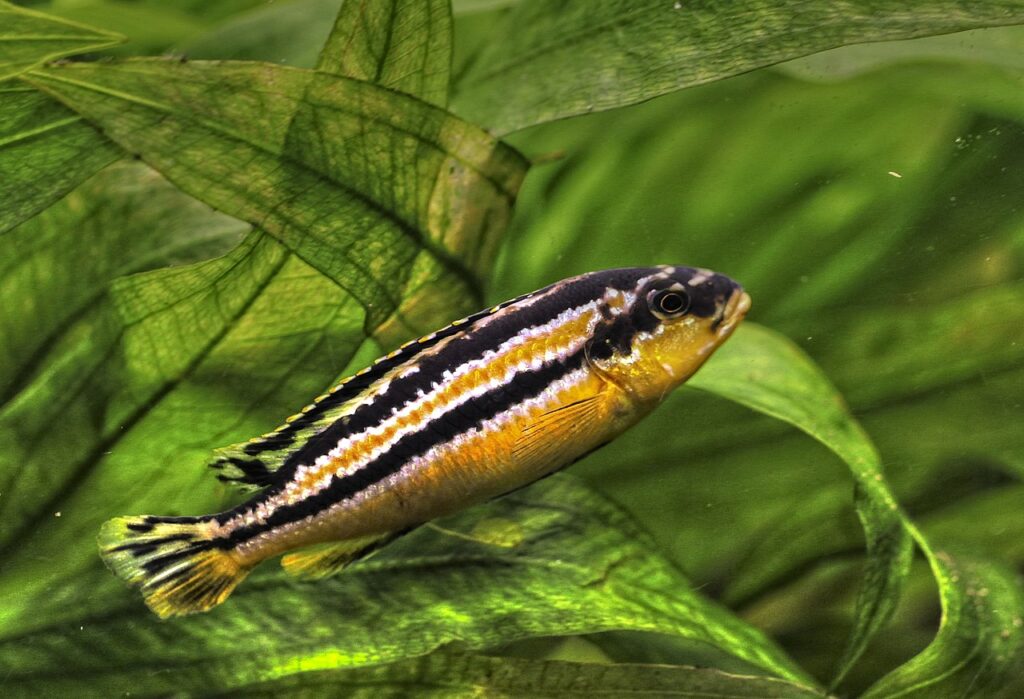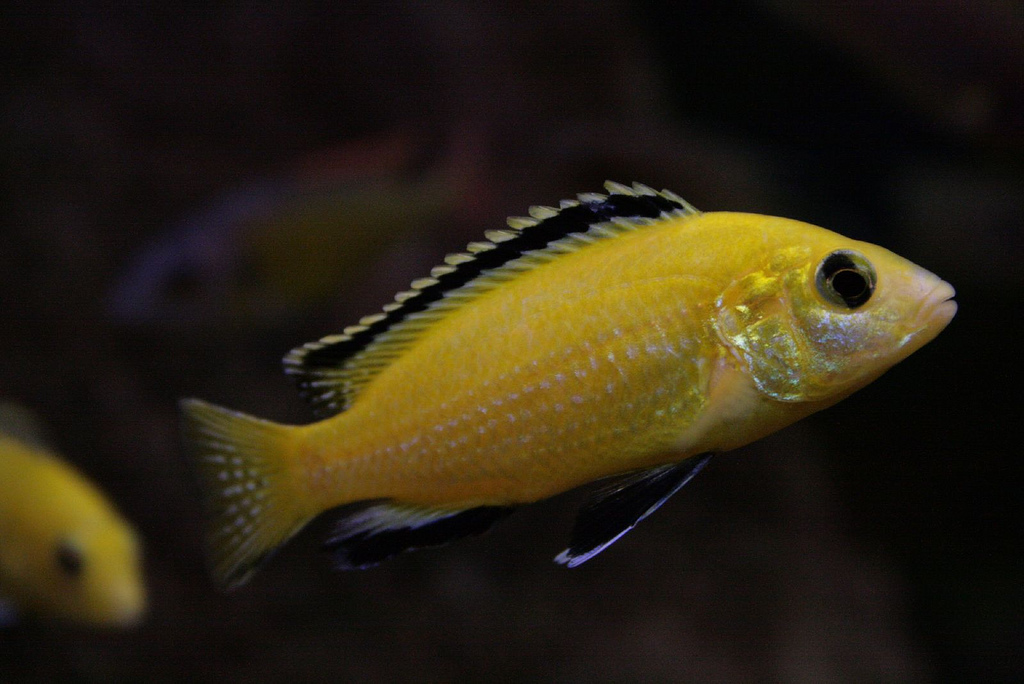The Golden Mbuna is a fish that catches the eye and sparks interest. Its bright yellow and black colors make it stand out in any tank. This small fish packs a big punch with its lively nature.
Table of Contents
These fish come from the rocky areas of Lake Malawi. They like to stay near the bottom, hiding in caves and cracks. In tanks, they need lots of space and places to hide. They can be tough to keep because they often fight with other fish.
The name Melanochromis auratus means “golden” in Latin. This fits perfectly with their shiny yellow color. People who sell fish also call them Auratus Cichlid or Malawi Golden Cichlid.
These fish eat both plants and tiny animals. In tanks, they should get dry food, fresh food, and frozen food. A mix of foods helps keep them healthy.
One cool thing about Golden Mbuna is how they have babies. The mom holds the eggs and baby fish in her mouth for weeks. This keeps them safe until they’re ready to swim on their own.
Golden Mbuna can grow up to 4.3 inches long, but most are about 3.1 inches. They can live for 8 years if you take good care of them. They’re only found in Lake Malawi, but some have been brought to the U.S. and Israel.
Not much research has been done on these fish. But some people have looked at how they affect other fish when they’re sold for tanks. The U.S. Fish & Wildlife Service has checked if they might cause problems in new places.
Golden Mbuna have been popular in fish tanks for a long time. They were first described in 1897 by a man named George Albert Boulenger. Since then, many people have enjoyed keeping them.
These fish are part of the cichlid family. This group has many colorful fish that people like to keep in tanks. Golden Mbuna stand out even among these bright fish.
In my view, Golden Mbuna are interesting because of their bold colors and lively behavior. They’re not easy to keep, which makes them a fun challenge for people who know a lot about fish.

Golden Mbuna Key Information
The Golden Mbuna, a striking cichlid from Lake Malawi, captivates aquarium enthusiasts with its vibrant coloration. Males display a dazzling golden-yellow body adorned with bold black stripes, while females showcase a more subdued palette of brown or gray with dark vertical bars. This color contrast not only adds visual interest to aquariums but also plays a crucial role in the species’ social interactions and breeding behaviors.
| Family | Cichlidae |
| Origin | Lake Malawi, Africa |
| Price | $10-$30 per fish |
| Common Names | Auratus Cichlid, Malawi Golden Cichlid |
| Variants | Wild-type, captive-bred |
| Ideal Tank Size | 55 gallons or larger |
| Water Parameters | pH 7.8-8.6, hardness 10-25 dGH, temp 74-82°F |
| Lifespan | Up to 8 years |
| Full Size | 3-4 inches |
| Natural Environment | Rocky areas in Lake Malawi |
| Behavior | Aggressive, territorial |
| Habitat Preference | Bottom-dweller, rocky areas |
| Aquarium Decoration | Rocks, caves, sand substrate |
| Ideal Tank Mates | Other mbuna species, larger peaceful cichlids |
| Fish to Avoid | Small, peaceful fish, slow-moving species |
| Best Foods/Diet | Algae-based flakes, spirulina, vegetables |
| Disease | Prone to ich, bloat if stressed |
| Sex-switch | No known sex-switching behavior |
| Gender Differences | Males more colorful, females duller |
| Care Level | Intermediate to advanced |
| Breeding Level | Moderate difficulty, mouthbrooder |
Ideal Tank Mates for Golden Mbuna
When selecting tank mates for the Golden Mbuna, it’s crucial to choose species that can withstand its aggressive nature and thrive in similar water conditions. Ideal companions are often other African cichlids, particularly those from Lake Malawi, as they share similar environmental needs and can hold their own in a lively tank setting.
It’s important to note that while these fish can coexist with Golden Mbuna, careful monitoring is necessary, especially during the initial introduction period. Providing ample space, plenty of hiding spots, and maintaining proper water parameters are key factors in ensuring a harmonious community tank.
Here are 10 ideal tank mates for the Golden Mbuna, each with its unique characteristics and reasons for compatibility:
Yellow Lab Cichlid

The Yellow Lab Cichlid is a popular choice due to its vibrant coloration and relatively peaceful nature among mbuna species. Its bright yellow hue complements the Golden Mbuna’s colors, creating an visually appealing tank.
| Common/Market Names | Price Range | Care Level | Behavior | Life Span | Max Size |
|---|---|---|---|---|---|
| Electric Yellow, Lemon Drop | $10-$30 | Intermediate | Semi-aggressive | 6-8 years | 4 inches |
Acei Cichlid
Acei Cichlids are known for their striking blue coloration and peaceful temperament. They’re one of the more docile mbuna species, making them a good balance to the Golden Mbuna’s aggression.
| Common/Market Names | Price Range | Care Level | Behavior | Life Span | Max Size |
|---|---|---|---|---|---|
| Yellow Tail Acei, Blue Msuli | $15-$40 | Intermediate | Peaceful | 8-10 years | 5 inches |
Red Zebra Cichlid
The Red Zebra Cichlid brings a burst of orange to the tank. Its similar size and temperament to the Golden Mbuna make it a suitable tank mate, able to hold its own in territorial disputes.
| Common/Market Names | Price Range | Care Level | Behavior | Life Span | Max Size |
|---|---|---|---|---|---|
| Estherae, Cherry Red Zebra | $10-$25 | Intermediate | Semi-aggressive | 7-10 years | 5 inches |
Demasoni Cichlid
Demasoni Cichlids are small but feisty, matching the Golden Mbuna in spirit. Their striking blue and black stripes create an interesting contrast in the aquarium.
| Common/Market Names | Price Range | Care Level | Behavior | Life Span | Max Size |
|---|---|---|---|---|---|
| Midnight Demasoni, Pombo Rocks | $15-$30 | Advanced | Aggressive | 5-8 years | 3 inches |
Rusty Cichlid
The Rusty Cichlid, with its unique reddish-brown coloration, adds diversity to the tank. It’s less aggressive than many mbuna species, making it a good buffer in the community.
| Common/Market Names | Price Range | Care Level | Behavior | Life Span | Max Size |
|---|---|---|---|---|---|
| Red Cobalt Zebra, Lilac | $10-$25 | Intermediate | Mild-tempered | 6-8 years | 4 inches |
Socolofi Cichlid
Socolofi Cichlids, with their powder blue coloration, provide a soothing visual element to the tank. They’re hardy and can withstand the Golden Mbuna’s territorial behavior.
| Common/Market Names | Price Range | Care Level | Behavior | Life Span | Max Size |
|---|---|---|---|---|---|
| Powder Blue Cichlid, Snow White | $10-$25 | Intermediate | Semi-aggressive | 7-10 years | 5 inches |
Kenyi Cichlid
The Kenyi Cichlid is known for its dramatic color change as it matures. Its robust nature and similar size make it a good match for the Golden Mbuna.
| Common/Market Names | Price Range | Care Level | Behavior | Life Span | Max Size |
|---|---|---|---|---|---|
| Lombardoi, Maylandia lombardoi | $10-$20 | Advanced | Aggressive | 6-8 years | 4 inches |
Red Top Zebra
Red Top Zebras are attractive and hardy, able to withstand the Golden Mbuna’s aggression. Their striking red dorsal fins add a pop of color to the aquarium.
| Common/Market Names | Price Range | Care Level | Behavior | Life Span | Max Size |
|---|---|---|---|---|---|
| Red Top Cobalt Zebra | $15-$30 | Intermediate | Semi-aggressive | 7-10 years | 5 inches |
Johanni Cichlid
Johanni Cichlids are known for their beautiful blue coloration in males. They’re active swimmers and can keep up with the Golden Mbuna’s energy levels.
| Common/Market Names | Price Range | Care Level | Behavior | Life Span | Max Size |
|---|---|---|---|---|---|
| Blue Johanni, Maingano | $10-$25 | Intermediate | Semi-aggressive | 6-8 years | 4 inches |
Afra Cichlid
Afra Cichlids, with their vibrant blue and orange coloration, add a splash of color to the tank. They’re less aggressive than some mbuna species, providing a good balance to the Golden Mbuna’s temperament.
| Common/Market Names | Price Range | Care Level | Behavior | Life Span | Max Size |
|---|---|---|---|---|---|
| Cobalt Zebra, Cynotilapia afra | $15-$30 | Intermediate | Mildly aggressive | 7-10 years | 4 inches |
FAQs about Golden Mbuna
How often should I feed my Golden Mbuna?
Feed your Golden Mbuna small portions 2-3 times a day. They have small stomachs and do best with frequent, small meals rather than one large feeding.
Can Golden Mbuna live in a community tank with non-cichlid species?
It’s not recommended. Golden Mbuna are aggressive and territorial, making them unsuitable for community tanks with peaceful or smaller fish species.
Do Golden Mbuna need special lighting?
Standard aquarium lighting is sufficient for Golden Mbuna. They don’t have specific lighting requirements, but a regular day-night cycle is important for their well-being.
How can I tell if my Golden Mbuna is male or female?
Males are typically more brightly colored with intense yellow and black markings. Females are usually duller, often appearing brownish or grayish with less distinct patterns.
Are Golden Mbuna good jumpers?
Yes, they can be. It’s important to have a secure, well-fitting lid on your aquarium to prevent them from jumping out.
How many Golden Mbuna should be kept together?
It’s best to keep them in groups of at least 6, with more females than males. This helps distribute aggression and mimics their natural social structure.
Can Golden Mbuna change color?
While they don’t dramatically change color like some fish, their colors may become more intense or fade slightly based on factors like stress, diet, and breeding condition.
Do Golden Mbuna need air pumps or powerheads in their tank?
While not strictly necessary, powerheads or air pumps can be beneficial. They enjoy moderate water movement and well-oxygenated water.
How often should I change the water in a Golden Mbuna tank?
Regular partial water changes of about 20-30% every 1-2 weeks are recommended to maintain good water quality.
Can Golden Mbuna live with plants?
They’re not ideal tank mates for live plants as they may dig them up or eat them. If you want plants, choose hardy species and secure them well.